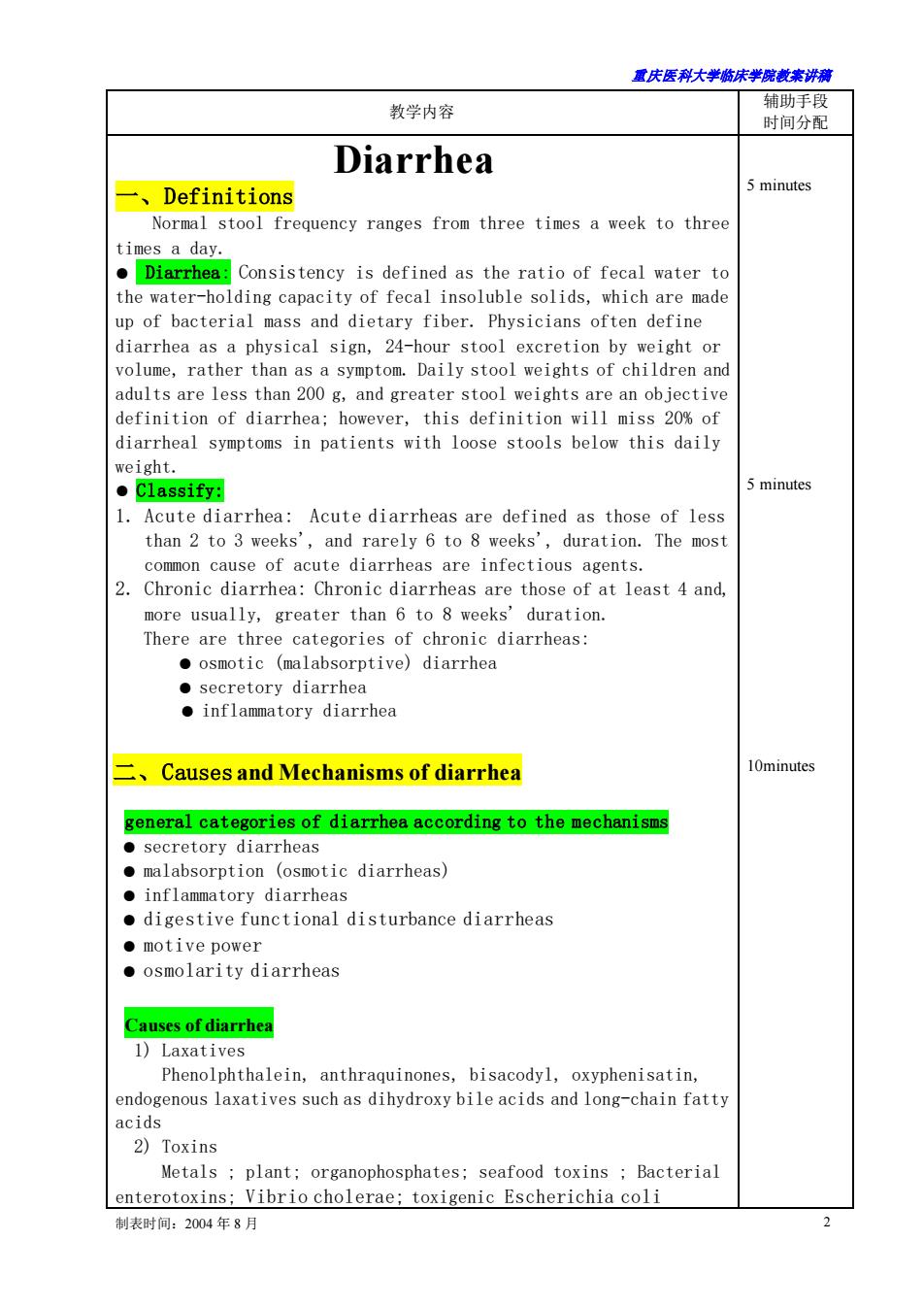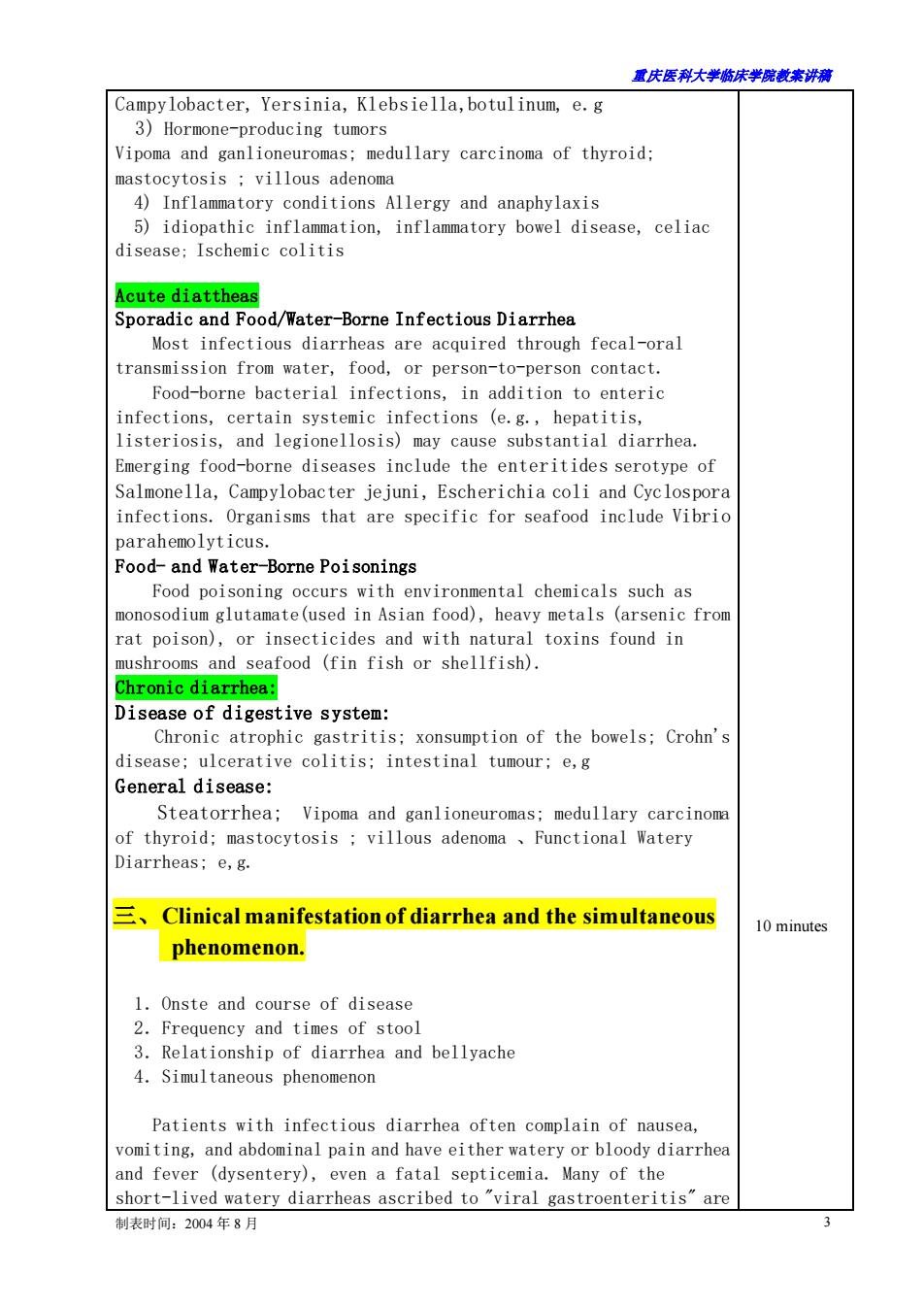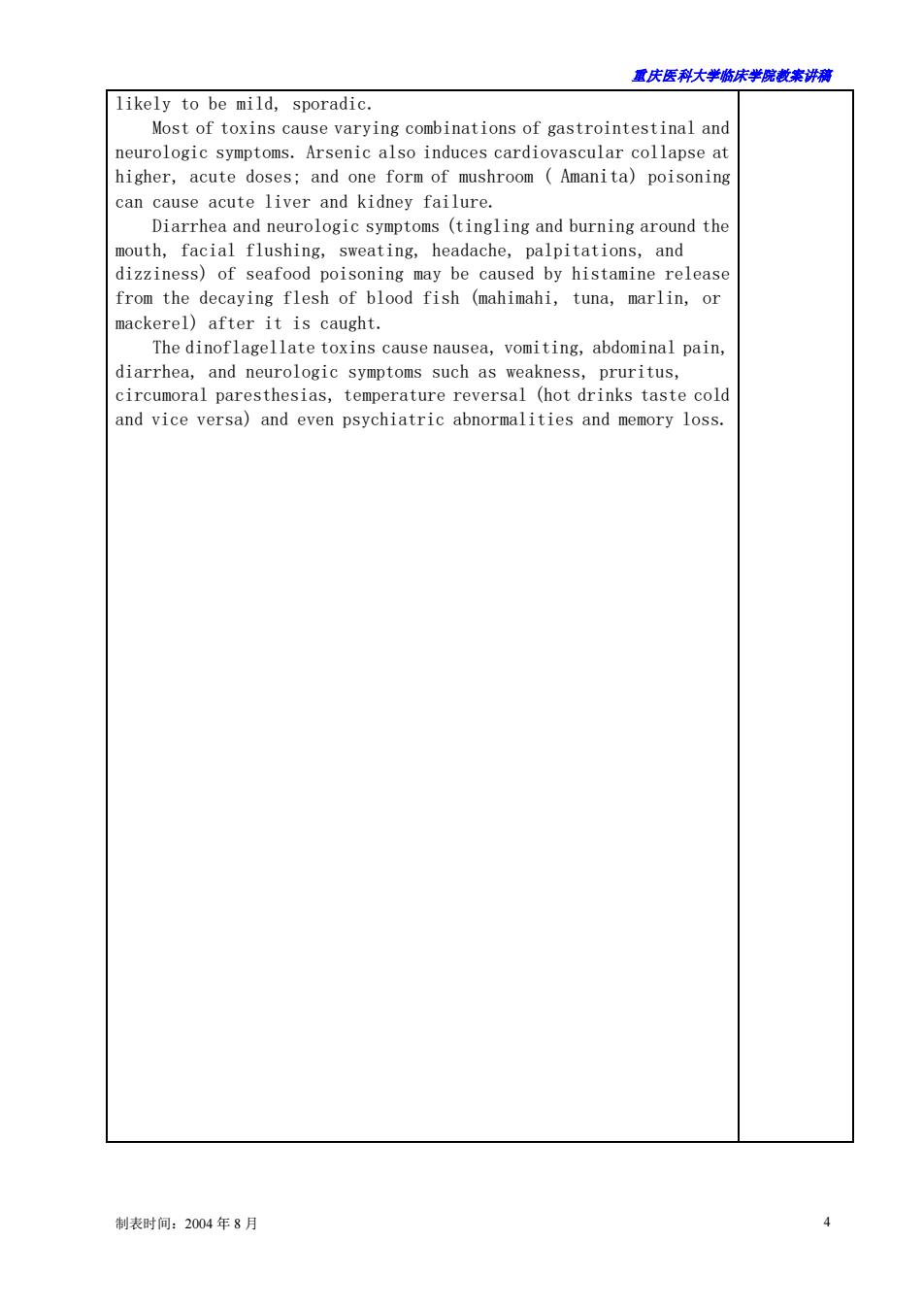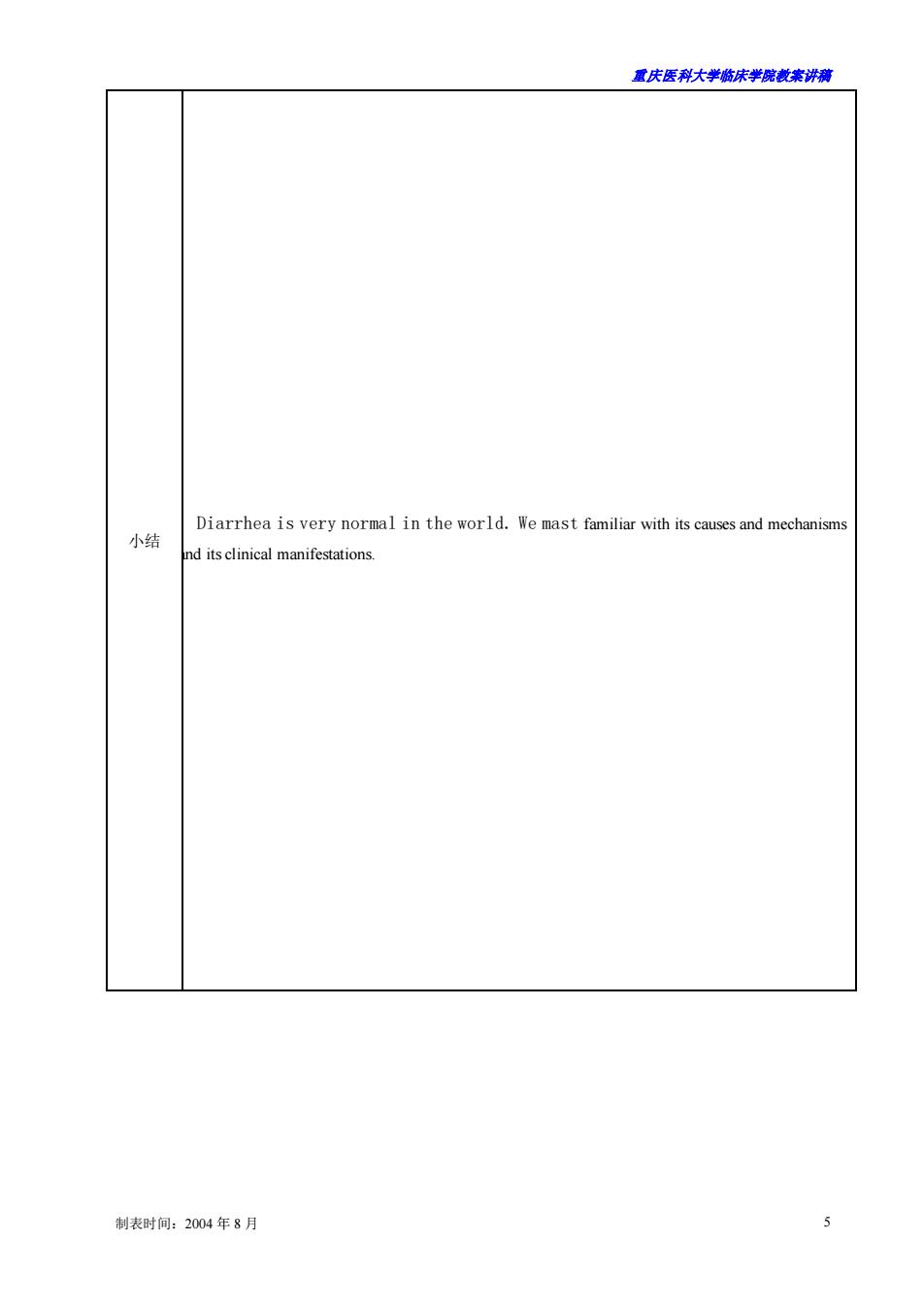
置庆医科大学脑床学院讲满 重庆医科大学临床学院教案及讲稿 课程名称诊断学 年级2005 授课专业临床医学 教师杜晓刚 职称副教授 授课方式 大课 学时1 题目章节腹泻 教材名称诊断学(双语) 作者吕卓人雷寒 出版社科学出版社 版次第一版 comprehend patho-physiological mechanisms of diarrhea 2. Be familiar with causes of diarrhea 的要求 Master the clinical manifestation of diarrhea and the sense to etiopathogenisis by simultaneous phenomenon. Mechanisms of diarrhea 教学难点 2. Causes of diarrhea 教学重点 1.Causes and differential diagnosis of diarrhea English Multimedia methods 手段 1.Teaching outline of diagnostics Cecil text book of medicine (edition) 教研 见 制表时间:2004年8月
重庆医科大学临床学院教案讲稿 制表时间:2004 年 8 月 1 重庆医科大学临床学院教案及讲稿 课程名称 诊断学 年级 2005 授课专业 临床医学 教 师 杜晓刚 职称 副教授 授课方式 大课 学时 1 题目章节 腹泻 教材名称 诊断学(双语) 作者 吕卓人 雷寒 出 版 社 科学出版社 版次 第一版 教 学 目 的 要 求 11. comprehend patho-physiological mechanisms of diarrhea 12. Be familiar with causes of diarrhea 13. Master the clinical manifestation of diarrhea and the sense to etiopathogenisis by simultaneous phenomenon. 教 学 难 点 11. Mechanisms of diarrhea 12. Causes of diarrhea 教 学 重 点 1. Causes and differential diagnosis of diarrhea 外语 要求 English 教学 方法 手段 Multimedia methods 参考 资料 1、Teaching outline of diagnostics 2、Cecil text book of medicine (21st edition) 教研 室意 见

露庆医科大学临床半院载案讲满 教学内容 辅助手段 时间分配 Diarrhea 一、Definitions minutes Normal stool frequency ranges from three times a week to three imes a day Diarrhea Consistency is defined as the ratio of fecal water the water-holding capacity of fecal insoluble solids,which are made up of bacterial mass and dietary fiber.Physicians often define diarrhea as a physical sign.24-hour stool excretion by weight or volume,rather than as a symptom.Daily stool weights of children and adultsare less and greater stoo definition of diarrhea:however,this definition will miss 20%of diarrheal symptoms in patients with loose stools below this daily weight. ●C1 assify: minutes 1. Acute diarrhea:Acute diarrheas are defined as those of less than 2 to 3 weeks',and rarely 6 to 8 weeks',duration.The most common cause of acute diarrheas are infectious agents. 2.Chronic diarrhea:Chronic diarrheas are those of at least 4 and, osmotic (malabsorptive)diarrhea ●secretory diarrhea inflammatory diarrhea 二、Causes and Mechanisms of diarrhea 10minutes general categories of diarrhea according to the mechanisms ●secretory diarrheas malabsorption (osmotic diarrheas) inflammtory diarrheas digestive functional disturbance diarrheas ●motive power osmolarity diarrheas Causes of diarrhea 1)Laxatives Phenolphthalein,anthraquinones,bisacodyl,oxyphenisatin, endogenous laxatives such as dihydroxy bile acids and long-chain fatty acids 2)Toxins Metals plant;organophosphates;seafood toxins Bacterial enterotoxins:Vibrio cholerae;toxigenic Escherichia coli 制表时间:2004年8月
重庆医科大学临床学院教案讲稿 制表时间:2004 年 8 月 2 教学内容 辅助手段 时间分配 Diarrhea 一、Definitions Normal stool frequency ranges from three times a week to three times a day. ● Diarrhea: Consistency is defined as the ratio of fecal water to the water-holding capacity of fecal insoluble solids, which are made up of bacterial mass and dietary fiber. Physicians often define diarrhea as a physical sign, 24-hour stool excretion by weight or volume, rather than as a symptom. Daily stool weights of children and adults are less than 200 g, and greater stool weights are an objective definition of diarrhea; however, this definition will miss 20% of diarrheal symptoms in patients with loose stools below this daily weight. ● Classify: 1. Acute diarrhea: Acute diarrheas are defined as those of less than 2 to 3 weeks', and rarely 6 to 8 weeks', duration. The most common cause of acute diarrheas are infectious agents. 2. Chronic diarrhea: Chronic diarrheas are those of at least 4 and, more usually, greater than 6 to 8 weeks' duration. There are three categories of chronic diarrheas: ● osmotic (malabsorptive) diarrhea ● secretory diarrhea ● inflammatory diarrhea 二、Causes and Mechanisms of diarrhea general categories of diarrhea according to the mechanisms ● secretory diarrheas ● malabsorption (osmotic diarrheas) ● inflammatory diarrheas ● digestive functional disturbance diarrheas ● motive power ● osmolarity diarrheas Causes of diarrhea 1) Laxatives Phenolphthalein, anthraquinones, bisacodyl, oxyphenisatin, endogenous laxatives such as dihydroxy bile acids and long-chain fatty acids 2) Toxins Metals ; plant; organophosphates; seafood toxins ; Bacterial enterotoxins; Vibrio cholerae; toxigenic Escherichia coli 5 minutes 5 minutes 10minutes

重庆医科大学脑床半院载未讲满 Campylobacter,Yersinia,Klebsiella,botulinum,e.g 3)Hormone -roducing tumors Vipoma and ganlioneuromas;medullary carcinoma of thyroid: mastocytosis villous adenoma 4)Inflammatory conditions Allergy and anaphylaxis 5)idiopathic inflammation,inflammatory bowel disease,celiac disease:Ischemic colitis Acute diattheas Sporadic and Food/Water-Borne Infectious Diarrhea Most infectious diarrheas are acquired through fecal-oral transmission from water,food,or person-to-person contact. Food-borne bacterial infections,in addition to enteric nfections certain systemic infections (e.g., epatitis, listeriosis,and legionellosis)may cause substantial diarrhea. Emerging food-borne diseases include the enteritides serotype of Salmonella,Campylobacter jejuni,Escherichia coli and Cyclospora infections.Organisms that are specific for seafood include Vibri parahemolyticus. Food-and Water-Borne Poisonings Food poisoning occurs with environmental chemicals such as monosodium glutamate(used in Asian food),heavy metals (arsenic from rat poison), or insecticides and with natural toxins found in mushrooms and seafood (fin fish or shellfish) Chronic diarrhea: Disease of digestive system: Chronic atrophic gastritis;xonsumption of the bowels;Crohn's disease;ulcerative colitis;intestinal tumour;e.g General disease: Steatorrhea:Vipoma and ganlioneuromas:medullary carcinom of thyroid:mastocytosis villous adenoma 、Functional Watery Diarrheas:e,g. Clinical manifestation of diarrhea and the simultaneous 10 minutes phenomenon. 1.Onste and course of disease 2.Frequency and times of stool 3.Relationship of diarrhea and bellyache 4.Simultaneous phenomenon Patients with infectious diarrhea often complain of nausea, vomiting,and abdominal pain and have either watery or bloody diarrhea and fever (dysentery),even a fatal septicemia.Many of the short-lived watery diarrheas ascribed to "viral gastroenteritis"are 制表时间:2004年8月
重庆医科大学临床学院教案讲稿 制表时间:2004 年 8 月 3 Campylobacter, Yersinia, Klebsiella,botulinum, e.g 3) Hormone-producing tumors Vipoma and ganlioneuromas; medullary carcinoma of thyroid; mastocytosis ; villous adenoma 4) Inflammatory conditions Allergy and anaphylaxis 5) idiopathic inflammation, inflammatory bowel disease, celiac disease; Ischemic colitis Acute diattheas Sporadic and Food/Water-Borne Infectious Diarrhea Most infectious diarrheas are acquired through fecal-oral transmission from water, food, or person-to-person contact. Food-borne bacterial infections, in addition to enteric infections, certain systemic infections (e.g., hepatitis, listeriosis, and legionellosis) may cause substantial diarrhea. Emerging food-borne diseases include the enteritides serotype of Salmonella, Campylobacter jejuni, Escherichia coli and Cyclospora infections. Organisms that are specific for seafood include Vibrio parahemolyticus. Food- and Water-Borne Poisonings Food poisoning occurs with environmental chemicals such as monosodium glutamate(used in Asian food), heavy metals (arsenic from rat poison), or insecticides and with natural toxins found in mushrooms and seafood (fin fish or shellfish). Chronic diarrhea: Disease of digestive system: Chronic atrophic gastritis; xonsumption of the bowels; Crohn's disease; ulcerative colitis; intestinal tumour; e,g General disease: Steatorrhea; Vipoma and ganlioneuromas; medullary carcinoma of thyroid; mastocytosis ; villous adenoma 、Functional Watery Diarrheas; e,g. 三、Clinical manifestation of diarrhea and the simultaneous phenomenon. 1.Onste and course of disease 2.Frequency and times of stool 3.Relationship of diarrhea and bellyache 4.Simultaneous phenomenon Patients with infectious diarrhea often complain of nausea, vomiting, and abdominal pain and have either watery or bloody diarrhea and fever (dysentery), even a fatal septicemia. Many of the short-lived watery diarrheas ascribed to "viral gastroenteritis" are 10 minutes

露庆医科大学脑床半院藏来讲滴 likely to be mild,sporadic. Most of toxins cause varying combinations of gastrointestinal and neurologic symptoms.Arsenic also induces cardiovascular collapse at higher,acute doses;and one form of mushroom Amanita)poisoning can cause acute liver and kidney failure. Diarrhea and neurologic symptoms(tingling and burning around the nouth,facial flushing,sweating,headache,palpitations,and dizziness)of seafood poisoning may be caused by histamine release from the decaying flesh of blood fish (mahimahi,tuna,marlin,or mackerel)after it is caught. The dinoflagellate toxins cause nausea,vomiting,abdominal pain diarrhea, and neurologi symptoms pruritus, circumoral paresthesias.terperatureversa hot rinks tasto col and vice versa)and even psychiatric abnormalities and memory loss. 制表时间:2004年8月 4
重庆医科大学临床学院教案讲稿 制表时间:2004 年 8 月 4 likely to be mild, sporadic. Most of toxins cause varying combinations of gastrointestinal and neurologic symptoms. Arsenic also induces cardiovascular collapse at higher, acute doses; and one form of mushroom ( Amanita) poisoning can cause acute liver and kidney failure. Diarrhea and neurologic symptoms (tingling and burning around the mouth, facial flushing, sweating, headache, palpitations, and dizziness) of seafood poisoning may be caused by histamine release from the decaying flesh of blood fish (mahimahi, tuna, marlin, or mackerel) after it is caught. The dinoflagellate toxins cause nausea, vomiting, abdominal pain, diarrhea, and neurologic symptoms such as weakness, pruritus, circumoral paresthesias, temperature reversal (hot drinks taste cold and vice versa) and even psychiatric abnormalities and memory loss

置庆医科大学脑床半院末讲满 Diarrhea is very normal in the world.We mast familiar with its causes and mechanisms 小结 d itsincamnifestations 制表时间:2004年8月
重庆医科大学临床学院教案讲稿 制表时间:2004 年 8 月 5 小结 Diarrhea is very normal in the world. We mast familiar with its causes and mechanisms and its clinical manifestations